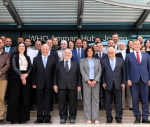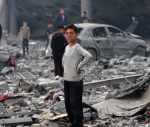The battlefields of Syria and Iraq have merged as opposition groups fighting the regime of Bashar Assad combined their efforts to drive out radical fighters belonging to the notorious Islamic State of Iraq and the Levant (ISIL) from liberated areas in the north.
In Iraq’s Anbar province, local Sunni tribes came together to evict Al Qaeda and ISIL forces from Ramadi and Fallujah.
The outcome of these two confrontations will determine the course of the Syrian civil war and the fate of the dysfunctional political process in Iraq.
It is a chaotic scene in Syria.
New alliances are emerging among various rebel factions as old ones crumble. Syrian rebels have gathered under the umbrella of the Islamic Front, an alliance of supposedly moderate Islamist groups, the Mujahedeen Army with ties to the Free Syrian Army (FSA) and the Syria’s Thuwar or rebels.
Jabhat Al Nusra, which is affiliated with Al Qaeda, is yet to adopt a position on ISIL. The latter was accused by the Syrian opposition of colluding with the Damascus regime. It committed atrocities against civilians and fellow rebels.
Interestingly enough, Al Qaeda’s Ayman Al Zawahiri distanced the terrorist organisation from ISIL last year.
ISIL is a relative newcomer to Syria’s battlefields. It is believed to have been formed by the Syrian regime to fight the US military in Iraq after the 2003 invasion.
Like Jabhat Al Nusra, it is composed of foreign and Arab fighters. Its leader, Abu Baker Al Baghdadi, is seeking to establish an Islamist emirate in Iraq and Syria.
The Syrian opposition in exile believes it is infiltrated by the regime.
These fratricidal wars are a boon to the Assad regime, which has always claimed that it was fighting foreign jihadists backed by Syria’s enemies.
ISIL, whose fighters control large swathes of Aleppo and Idlib, threatened to abandon frontline posts that could be taken over by regime forces.
In addition, the Damascus regime’s warning that the crisis could spill across the borders of neighbouring countries has come true, as the fight in Anbar demonstrates.
Lebanon is another example of how the fighting between various groups in Syria can cross the porous borders.
Recently, salafist jihadists in Jordan were reported to have vowed to transfer the fight into Lebanon as a response to Hizbollah’s military presence in Syria.
Similar spillovers could threaten northern Kurdish areas between Syria and Iraq, southern Turkey and northern Jordan, where radical Islamist groups have established a foothold.
What is happening in Anbar province will have an effect on the outcome of the current struggle in northern Syria.
Anbar had become an important base for Al Qaeda during the US occupation of Iraq. Sunni tribes there offered Islamist militants refuge, but as their power grew, influential sheikhs joined the awakening movement that drove the fighters out of the main cities in the province.
The failure of Prime Minister Nouri Maliki to appease the Sunnis by including them in the political process has alienated Anbar again, allowing militants to come back.
Presently the tribes of Anbar want to drive the militants out, but are wary of Maliki’s plans to launch a massive military campaign against their cities.
Ironically, both Assad and Maliki are claiming to be fighting Al Qaeda while pursuing policies that have brought sectarian tensions to a boiling point.
The current fighting in northern Syria is crucial for anti-regime rebels. It could prove to be a turning point for the opposition, which has failed to unite its forces under one banner.
Eradicating ISIL will bring them together for some time, but the fact is that no one believes in a political process to end the war in Syria.
Even worse, the political opposition in exile has little or no influence over the combatants.
In addition to this, many of the newly formed military alliances share the general goal of establishing an Islamic state in Syria.
It is a far cry from the original objectives of the Syrian uprising, which declared that it wants to establish a democratic, pluralistic and civil state.
Eventually the various fronts and groups on the ground will have the final say. The possibility of future internecine infightings is not far fetched.
In Iraq and Syria, the threat of further weakening of the central authority of the state is now a reality. And in both, the spectre of sectarian confrontations, on the one hand, and fratricidal killings, on the other, will continue to haunt the peoples of these countries.
The vast area between eastern Syria and western Iraq will prove to be one of the biggest security challenges for the region in 2014.
It is not unlikely that rebel groups of various affiliations will fight among each other for control and authority.
It is a preface for partition that now threatens the geopolitical integrity of the two afflicted countries.
The writer is a journalist and political commentator based in Amman.













